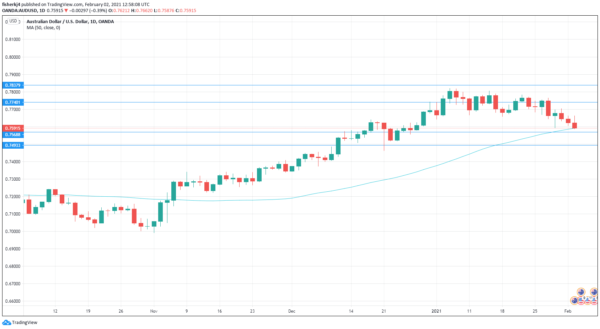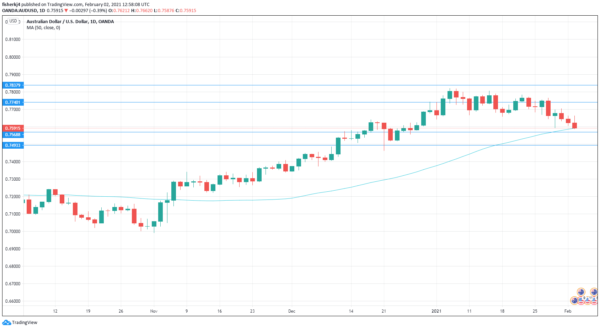The Australian dollar has recorded slight losses on Tuesday. Currently, AUD/USD is trading at 0.7599, down 0.28% on the day. Earlier in the day, the Aussie fell below the 0.76 level for the first time in 2021.
RBA extends QE program
The RBA held its first policy meeting of the year, and the message to the markets was decidedly dovish. There was no surprise as the central bank maintained its cash rate at 0.10%, where it has been pegged since November. However, there has been talk that the RBA could take a less dovish stance, given the strong performance of the Australian economy, which has rebounded nicely from the Covid crisis. The labor market is recovering, consumer spending is rising and the housing market is strong. The markets were clearly expecting a move in response to the good economic news, as AUD/USD rose 0.50% just before the RBA decision was released. However, the RBA move to extend QE was not what traders had expected from the bank, and the pair weakened after the decision.
Currently, the central bank’s purchase of government bonds (QE) is about halfway through its six-month duration, The RBA announced that it will extend the scheme, with a pace of AUD5 billion each week, for another six months. The rate statement acknowledged the improvement in the labor market, but also noted that inflation remains below the target of 2-3%. The bank also stated that it did not expect to raise rates prior to 2024, as policymakers are following the Federal Reserve’s lead and have poured cold water on any speculation of tapering QE anytime soon. If the RBA would have kept tapering on the table, it would have likely boosted the Aussie, which is something the RBA does not want to see, given its sharp appreciation against the US dollar in recent months.
AUD/USD Technical

- 0.7740 is the first line of resistance, following by resistance at 0.7838
- There is support at 0.7568. Below, we have support at 0.7494
- AUD/USD is testing the 50-day moving average (MA). A daily close below this line is a bearish technical signal


 Signal2forex.com - Best Forex robots and signals
Signal2forex.com - Best Forex robots and signals




